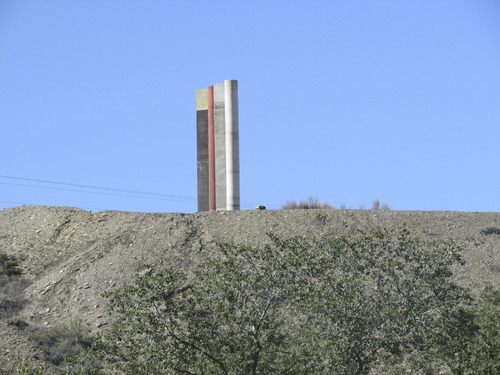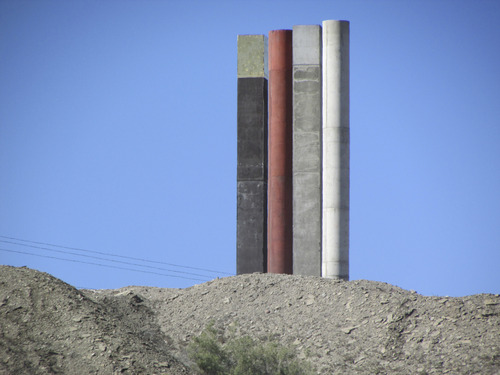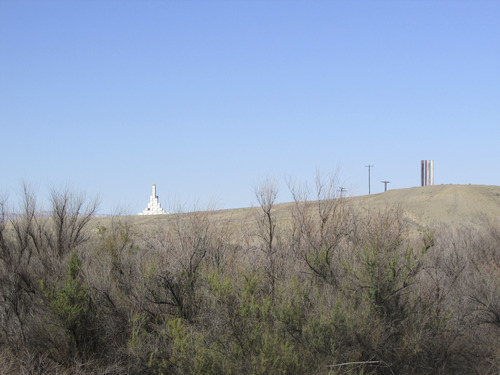This is an archived article that was published on sltrib.com in 2013, and information in the article may be outdated. It is provided only for personal research purposes and may not be reprinted.
Green River • The cryptic message seemed so strange that Australian artist Andrew Rogers almost thought it came from a friend trying to play a joke.
"I represent a client with a 75-acre parcel near Green River, Utah, a scenic desert landscape in east central Utah," wrote Salt Lake lawyer Scott Jenkins to the artist in 2010. "My client is possibly interested in a land art project on his property. He is 88 years old and wants to leave a lasting mark of some kind."
Intrigued, possibly because Rogers owned a fossil collected from near this southeastern town, the artist did some investigating and ended up completing a 44-foot-high sculpture called "The Ratio," based on the Fibonacci sequence, a mathematical concept of universal significance similar to the Golden Ratio of science and mathematics. It was capped with 23-carat gold, to reflect the sun's rays for miles in each direction. It contains two black stones representing the dangers of genetic engineering.
That sculpture, financed by the property owner, a blind Seattle schoolteacher and railroad buff named Herbert Steiner, is obvious to those driving along Interstate 70 who see the unusual sculpture just north of the freeway.
Now "The Ratio" has a companion.
Completed in early September, Rogers' newest creation, "Elements," also financed by Steiner, consists of four 33-foot-high columns representing the basic elements of earth, fire, water and wind. One of the columns is also capped with 23-carat gold.
This second piece of artwork, near "The Ratio" on the same dusty hill between I- 70 and the Green River Amtrak station on the south end of what passes for the town's business district, is not quite as obvious for interstate travelers. It is best viewed from near the train station where Steiner discovered Green River nearly 30 years ago.
These two creations are among 48 large-scale stone structures Rogers has created in 13 countries across seven continents in what he calls the "Rhythms of Life Land Art" series.
Steiner, who has never been married, said he views the two sculptures as his way to achieve immortality. He hopes they will remain in place for hundreds of years, much like the statues on Easter Island or the columns at England's Stonehenge. "I am fascinated with this happening in Green River," said Steiner, 91. "It is beyond my greatest dreams. I'm immortal. That thing is concrete. Andrew created something like a great work of art that will survive for generations."
In writing about his motivations for financing the land sculptures, Steiner said most people put themselves in a cemetery with their names on a grave and, as the years pass, are forgotten.
"My mother and father and brother are all buried in a cemetery called Washeli," he wrote. "They have tombstones and urns and you can go and take them out, but who in the hell is going to do that? And no one wants to carry around ashes. These sculptures are the most important thing I'm leaving behind."
Steiner first rode an Amtrak train into the remote town of Thompson, east of Green River, in the early 1980s, when he was 62 and could still see. He discovered that the Southern Pacific Railroad's land division was selling surplus property in the area at highly discounted rates.
Working with Jenkins, he bought land, including the 75-acre plot where "The Ratio" and "Elements" are. To finance some of Rogers' work, he sold some of the land to Utah State Parks for its Green River golf course and to Green River City for a sewage treatment plant.
Rogers, who is working on some bronze sculptures in Montreal, said the Green River area appeals to him.
"I like deserts," he said in a phone interview. "They are pristine, clean and unspoiled. Around that area, it's pretty good. Green River has lots of history and heritage. There are Indian pictographs nearby. It's an interesting town, set on the intersection of those highways."
He said he tried to position "Elements" in harmony with "The Ratio" and that the two pieces, in their own way, are connected.
"I hope that people appreciate the beauty of the environment when they see these things," said Rogers. "I hope they think about the message contained within them and reflect on what's important in life. They will last a long time. They will become a fulcrum for contemplation and a domain of speculation."
Will there be more sculptures on the hill above Green River?
Perhaps.
In an email, Rogers said Steiner is talking about another sculpture. He has proposed a 65-foot-high single tapering column, the top of which would be also covered with 23-carat gold. This would be a Fibonacci column, designed to have synergy with "The Ratio."
Twitter: @tribtomwharton











